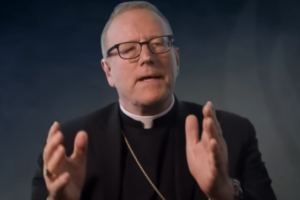Word on Fire—Now that I’ve had a bit of time to readjust to my normal rhythm and to think through the rather extraordinary experience of the last month in Rome, I would like to share some impressions of the Synod on Synodality, even as I will endeavor not to violate the pope’s request that we refrain from talking about particular participants and votes.
So, I will limit myself to commenting on the published document that the synod members approved and on my own interventions during the deliberations.
The summary statement very accurately expresses the fact that the overwhelming concern of the synod members was to listen to the voices of those who have, for a variety of reasons, felt marginalized from the life of the Church. This motif was the common denominator in all of the preliminary sessions leading up to the synod, and it was prominently featured in the working document that provided the  basis for our discussions. Women, the laity in general, the LGBT community, those with disabilities, young people, men and women of color, etc. have felt unappreciated and, most importantly, excluded from the tables where decisions are taken that affect the whole life of the Church.
basis for our discussions. Women, the laity in general, the LGBT community, those with disabilities, young people, men and women of color, etc. have felt unappreciated and, most importantly, excluded from the tables where decisions are taken that affect the whole life of the Church.
I can assure everyone that their demand to be heard was heard, loud and clear at the synod. And I’m glad it was. The Church is meant to announce the Gospel to everyone (todos, todos, todos, as the pope rightly says) and to gather them into the Body of Christ. Therefore, if there are armies of Catholics who feel excluded or condescended to, that’s a major pastoral problem that must be addressed with humility and honesty. And I can say, as someone who has been a full-time ecclesiastical administrator for the past twelve years, I am delighted to receive the counsel of laity in regard to practically all aspects of my work. Expanding the number and diversity of those who might aid the bishops in their governance of the Church is all to the good, and bravo to the synod for exploring this possibility.
We must welcome everyone, but . . . at the same time must summon those we include to conversion , to live according to the truth.
A question that I raised several times in the small group conversations, however, was whether, in our enthusiasm to include people in the governance of the Church, we forget that the vocation of 99 percent of the Catholic laity is to sanctify the world, to bring Christ into the arenas of politics, the arts, entertainment, communication, business, medicine, etc., precisely where they have special competence.
Generally speaking, I was worried that both the Instrumentum Laboris and the synod conversations were far more preoccupied with the ad intra than with the ad extra, and this despite the fact that Pope Francis has been consistently calling for a Church that goes out from itself.
On a number of occasions during the synod, I proposed the Catholic Action model that was, in the preconciliar period, such an effective way to form the laity in their mission to the world.
Another principal theme of the synod discussions was the play or perceived tension between love and truth. On the one hand, we must welcome everyone, but lest this welcoming devolve into a form of cheap grace (to use Dietrich Bonhoeffer’s term), we at the same time must summon those we include to conversion, to live according to the truth.
As you might suspect, this issue became concretized around the outreach to the LGBT community. Practically everyone at the synod held that those whose sexual lives are outside of the norm should be treated with love and respect, and, again, bravo to the synod for making this pastoral point so emphatically. But many synod participants also felt that the truth of the Church’s moral teaching in regard to sexuality ought never to be set aside.
One of the interventions that I made to the plenary assembly was on this theme. I observed that, when the terms are rightly understood, there is no real tension between love and truth, for love is not a feeling but the act by which one wills the good of another. Therefore, one cannot authentically love someone else unless he has a truthful perception of what is really good for that person. There might, I argued, be a tension between welcoming and truth but not between authentic love and truth.
A third area of interest/concern for me centered around the notion of mission. The term “mission” was used constantly in the texts we considered and the conversations we had.
That the Church is a mission, to use Pope St. Paul VI’s language, was taken for granted by the synod members, and this represents a significant and very encouraging appropriation of the teaching of Vatican II and of the postconciliar papal magisterium. Pope St. John Paul II’s indefatigable teaching on the New Evangelization has evidently worked its way into the heart and mind of the worldwide Church.
But there was, at least to my mind, a fair amount of ambiguity around the meaning of the word itself. Judging from what we read in the Instrumentum Laboris, mission seemed, more often than not, to designate the Church’s work in favor of social justice and the betterment of the economic and political situation of the poor.
Conspicuous by their absence in the texts on mission were references to sin, grace, redemption, cross, resurrection, eternal life, and salvation, and this represents a real danger. For in point of fact, the primary mission of the Church is to declare the Resurrection of Jesus Christ from the dead and to invite people to place themselves under his Lordship.
This discipleship, to be sure, has implications for the way we live in the world, and it certainly should lead us to work for justice, but we must keep our priorities straight. The supernatural should never be reduced to the natural; rather, the natural order should be transfigured by its relationship to the supernatural order.
A final point—and here I find myself in frank disagreement with the final synodal report—has to do with the development of moral teaching in regard to sex. The suggestion is made that advances in our scientific understanding will require a rethinking of our sexual teaching, whose categories are, apparently, inadequate to describe the complexities of human sexuality.
A first problem I have with this language is that it is so condescending to the richly articulate  tradition of moral reflection in Catholicism, a prime example of which is the theology of the body developed by Pope St. John Paul II. To say that this multilayered, philosophically informed, theologically dense system is incapable of handling the subtleties of human sexuality is just absurd.
tradition of moral reflection in Catholicism, a prime example of which is the theology of the body developed by Pope St. John Paul II. To say that this multilayered, philosophically informed, theologically dense system is incapable of handling the subtleties of human sexuality is just absurd.
But the deeper problem I have is that this manner of argumentation is based upon a category error—namely, that advances in the sciences, as such, require an evolution in moral teaching.
Let us take the example of homosexuality. Evolutionary biology, anthropology, and chemistry might give us fresh insight into the etiology and physical dimension of same-sex attraction, but they will not tell us a thing about whether homosexual behavior is right or wrong. The entertaining of that question belongs to another mode of discourse.
It is troubling to see that some of the members of the German bishops’ conference are already using the language of the synod report to justify major reformulations of the Church’s sexual teaching. This, it seems to me, must be resisted.
I invite everyone to continue to pray for the work that we synod members must do both in the interim and at the Vatican next year.
The very best part of the synod was, of course, coming into close contact with Catholic leaders from all over the world. In my various small groups—and during the very lively coffee breaks—I met bishops and laity from the Philippines, Indonesia, Malaysia, Lithuania, Hong Kong, Germany, Canada, Mexico, Argentina, Austria, Australia, and on and on.
The four weeks in Rome was a uniquely privileged opportunity to sense the catholicity of Christ’s Church—and like it or not, this kind of encounter changes you, compelling you to see that your vision of things is one perspective among many.
All of these ideas and experiences from the synod will continue in the coming year to percolate in the mind of the Church, in preparation for the second and final round next October. Might I invite everyone to continue to pray for the work that we synod members must do both in the interim and at the Vatican next year?
———————
Bold and extra paragraph breaks made by Catholic Business Journal for easier readability only.





This seems like a good and respectful statement. But I might be missing something …